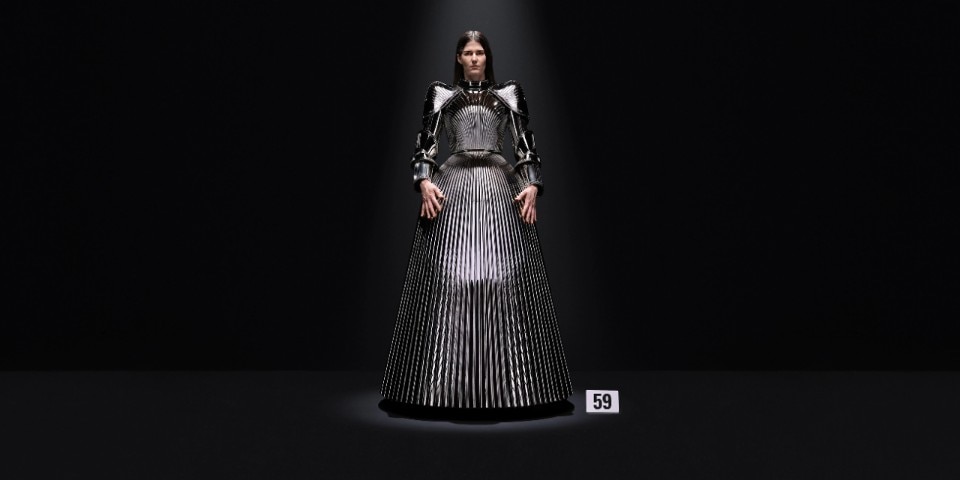When he was appointed creative director of Maison Balenciaga in 2015, Demna Gvasalia was a Georgian designer, just in his thirties, and rather unknown. Of course, he had proven to be a promising young talent, holding a degree from the Royal Academy of Fine Arts in Antwerp and having fruitful collaborations with Martin Margiela and Louis Vuitton. Furthermore, just the year before, he had founded the brand Vetements together with his brother Guram, whose first collection was curated and displayed within the spaces of Le Depot, a small Parisian gay club that was a central pillar of French queer culture and various subcultures since the 1970s.
It was a difficult task that Demna was ready to take on: since the painful retirement of founder Cristobal Balenciaga in 1968, the fashion house had remained dormant until 1986, only to be purchased by the Kering Group in 2001. Despite the sales, numbers, and success, Balenciaga was in desperate need of something new, something that would brush off the brand’s codes, remove the rust, and offer a more contemporary viewpoint while not turning its back on the past and tradition.
By transforming Balenciaga’s identity, Demna dove headfirst into a fashion market that was increasingly demanding and voracious, where only the strongest survive or the boldest moves succeed: a unique, reflective voice, unconcerned with becoming tainted by darkness or controversy, capable of observing contemporary society in all its facets, from uncomfortable politics to camp and kitsch, using provocation as an essential communication tool. Demna’s fashion dealt with oversized volumes and a dark, sometimes anti-human aesthetic, while street style infiltrated high fashion to define the new Balenciaga. “It’s my story now and I don’t want to try to be Cristóbal Balenciaga, which I could never be. But I can be myself,” he said in an interview with System Magazine in 2021. Keeping his promise, Demna was both the antithesis and the perfect heir to Cristobal, becoming Balenciaga himself and extending the brand everywhere.
It’s my story now and I don’t want to try to be Cristóbal Balenciaga, which I could never be. But I can be myself
However, Demna’s era at Maison Balenciaga was also destined to end: in a statement, the Kering Group just named Demna as the new creative director of Gucci, which last month bid farewell to Sabato De Sarno, who had failed to revive the fortunes of the Florentine house after Alessandro Michele's departure, now at Valentino. The official departure will happen in July with the last couture collection.
In this way, Demna also joins the creative director waltz, the term used in the fashion world to explain the inexhaustible comings and goings of designers between the most renowned Maisons. The news, completely unexpected, leaves many with great doubts: just as it happened ten years ago, Demna finds himself taking the reins of a prestigious fashion house that desperately needs to be revived. Will he be able to translate his already established and recognizable aesthetic to Gucci? But above all—the question everyone is asking—will Demna save Gucci, or will he deliver the final blow?
1. Kim e Demna al Met Gala, 2021
Many celebrities can boast the status of Balenciaga Ambassador, but Demna's ultimate muse has undoubtedly been Kim Kardashian, whose ability to build an extremely recognizable brand around herself the designer admires (one of Demna’s most coveted missions for Balenciaga). The two debuted as a creative duo in 2021 at the Met Gala, one of the most awaited and renowned fashion events of the year, strutting down the runway essentially as shadows, covered in black from head to toe, transforming into conceptual silhouettes that defiantly challenged the rules of fashion and the event itself.
2. Ritorno alla Haute Couture, 2021
Maison Balenciaga returned with its first haute couture collection after 53 years, signed by Demna Gvasalia. The more attentive observers could recognize in the solemn silence of the show, as if it were a religious ceremony, as well as in the number of the dress each model carried, nostalgic echoes of the modus operandi of the founder’s era. With this collection, Demna opened the door to further stylistic experimentation, debuting elements like jeans and sports sweatshirts as part of the new haute couture reality.
3. Autumn/Winter Collection, 2022
A capsule-shaped snowfield, where the models stumble down the hostile terrain. This is how Demna envisioned the AW 2022 collection, with a clear anti-war message that also drew on the personal history of the Georgian designer.
4. The Gift Shop Campaign Scandal, 2022
The risk of falling, especially when flying so high and provocatively, can become inevitable. Demna became the Icarus of 2022, with the ambiguous Christmas campaign featuring children accompanied by teddy bears dressed in handcuffs and chains, in blatant bondage style. These shots were accused of promoting child pornography, forcing the entire Maison and Demna himself to publicly apologize for the "misunderstanding," as well as to engage in a series of collaborations with human rights and child protection organizations.
5. Armor Dress from the Haute Couture Collection, 2023
A tribute to Joan of Arc, the shimmering armor worn by Eliza Douglas, with a bell-shaped skirt printed in 3D and chromium-plated, for the Couture Collection 2023. With this dress, Demna wanted to create a dreamlike reality where a garment becomes armor and protection, as well as a bridge connecting the inner self with the outer one. The dress is now displayed at the Louvre in Paris.
Opening Image: Picture © Demna


